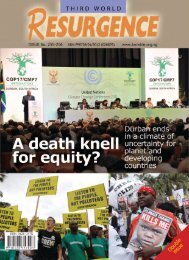Plantations, poverty and power - Critical Information Collective
Plantations, poverty and power - Critical Information Collective
Plantations, poverty and power - Critical Information Collective
You also want an ePaper? Increase the reach of your titles
YUMPU automatically turns print PDFs into web optimized ePapers that Google loves.
132<br />
Tim Synnott, then-FSC’s Policy Director, wrote a draft FSC Plantation Policy. Synnott’s draft paper<br />
acknowledged that “Disputes have arisen around plantation certification, with reports of infraction of FSC<br />
guidelines. Some of the disagreements <strong>and</strong> disputes have been caused by different interpretations of the<br />
FSC Principles <strong>and</strong> Criteria <strong>and</strong> other policies.”643<br />
At FSC’s General Assembly in 2002, a motion was passed for FSC to carry out a “<strong>Plantations</strong> Review”.<br />
The motion stated that “The current version of the FSC Plantation Policy Draft (30 May 2002) is not clear<br />
enough <strong>and</strong> needs improvement.” The motion continued to state that FSC should produce a revised<br />
plantation policy “after a broad consultation with the membership” to give “concrete guidance on the<br />
interpretation of P10 [Principle 10]“. This was supposed to take place within 18 months of the motion<br />
(i.e. by May 2004). 644 But six years after passing this motion, FSC has still not produced a revised<br />
plantation policy.<br />
At the 2002 FSC General Assembly, members passed another motion for a review of FSC’s chain of<br />
custody. This also had an 18 month deadline. The review involved creating a new label for “mixed<br />
sources”, effectively making it very much easier for paper companies to put FSC’s logo on their products.<br />
FSC used “mainly core funding” to carry out this review, according to Sofia Ryder, who worked in<br />
FSC’s policy <strong>and</strong> st<strong>and</strong>ards unit at the time.645 646<br />
When it came to the <strong>Plantations</strong> Review, no funding was available.<br />
In November 2003, a year after the motion was passed, FSC had made little or no progress towards<br />
carrying out a <strong>Plantations</strong> Review. Nevertheless, FSC produced a two page information leaflet titled<br />
“Forest <strong>Plantations</strong>”. The leaflet explains that FSC defines forest as “a tract of l<strong>and</strong> dominated by trees”.<br />
According to FSC, plantations are “forest areas lacking most of the principal characteristics <strong>and</strong> key<br />
elements of native ecosystems, which result from the human activities of planting, sowing or intensive<br />
silvicultural treatments.” As such, “<strong>Plantations</strong> are included in the FSC definition of forests”. Clearly,<br />
FSC was not going to consider too radical an approach to its <strong>Plantations</strong> Review, the outcome of which<br />
might include, for example, a definition of plantations making clear that they are not forests.<br />
643 Timothy Synnott (2002) “Review of FSC Plantation Policies: An FSC discussion paper. Clarification of FSC’s<br />
position on plantations”, Forest Stewardship Council, Draft, revised 18 July 2002.<br />
http://www.old.fsc.org/plantations/docs/Resources%20-%20FSC%20docs%20<strong>and</strong>%20reports/FSC-DIS-30-<br />
001%20FSC%20Plantation%20Policies_draft%20(2002).pdf<br />
644 “Final Motions <strong>and</strong> Results from the FSC General Assembly 2002”, FSC, 2002. http://www.fsc.org/fileadmin/webdata/public/document_center/general_assembly_documents/FSC_General_Assembly_2002_Final_Motions.pdf<br />
645 “Presentation by Sofia Ryder, FSC at Forest Movement Europe meeting”, 24 April 2004, Helsinki.<br />
646 It is worth noting where the use of “percentage based claims” (which later became the “mixed sources” label) within<br />
the FSC system comes from. In September 1995, FSC’s executive director, Tim Synnott, visited the Caperboard factory in<br />
Scotl<strong>and</strong>. Here’s his account of the visit:<br />
“The manager explained that his raw materials came from hundreds of municipal <strong>and</strong> industrial recycling schemes, from<br />
thinning operations in thous<strong>and</strong>s of different properties, <strong>and</strong> waste from countless sawmills, all derived from a long list of<br />
forests that varied every year. He recognized the public concerns about forest management quality, <strong>and</strong> also the right of<br />
industries to seek evidence of good management, but he knew that several years would pass before most of these forest<br />
properties would be certified. He was willing to start down this road, but only if he could get some recognition for the<br />
progress made towards fully certified raw materials, while continuing to use some raw materials from uncertified forests.<br />
After this visit, a policy for Percentage-Based Claims was a priority, that came into operation two years later.” Timothy<br />
Synnott (2005) “Some notes on the early years of FSC”, 19 November 2005, page 39. http://www.fsc.org/fileadmin/webdata/public/document_center/publications/Notes_on_the_early_years_of_FSC_by_Tim_Synnott.pdf















